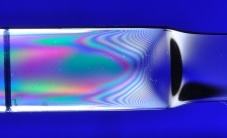Consider that immortal scene in the 1999 comedy hit “Analyze This” when Robert Deniro’s mobster weepily tells his psychiatrist, played by Billy Crystal, “I got stress!” Turns out dodging bullets, putting hits out on people and keeping his girlfriend out of his wife’s way was causing the classic tough guy to break down under the pressure. That can happen to polymers, too — minus the hits and girlfriend, of course.
When polymers — such as plastics — experience stress, one of the most common reactions is a color change: they turn white at the point of stress. If you’ve ever bent and/or broken a plastic rod or tube of any kind (such as your little brother’s Wiffle bat), you’ve seen this phenomenon in action.
Recently, we told you what causes plastic to turn yellow — typically, exposure to UV radiation. When whitening occurs in plastic, it has to do either with heat (molecular energy) or stress.
Most polymers contain both crystalline (neatly ordered) and amorphous (unordered) areas on their molecular chains. Heating a polymer can cause the amorphous sections of the chain to crystalize. When that happens, the way the molecules scatter light changes and the plastic turns white.
Simply bending something out of shape, or making the repeated bending motions needed to break it entirely (think about that Wiffle bat), can also cause molecular changes that lead to whitening. If you haven’t seen the whitening occur (or aren’t responsible for it yourself), you’ll need some polymer analysis to understand what happened to cause the changes in the plastic.
Two types of polymer testing are particularly useful when getting to the bottom of whitening: differential scanning calorimetry (DSC) and optical birefringence.
DSC helps us understand the thermal transitions that occur within a material, including residual reactivity, evaporation of solvents, melting, glass transition temperature and — you guessed it — crystallization. This analytical technique uses heating and cooling in extremes ranging from -90 to 725 degrees centigrade to help define these transitions. It’s a useful way to determine whether heat is the cause of whitening in a given plastic sample. Optical birefringence testing looks at how a material refracts light, and it can help us determine whether stress factors have caused a plastic sample to experience whitening. If stress factors were a cause for the whitening it can also indicate from where the stress originated.
Heat and stress can wear on anyone — mob bosses and polymers, alike. When mobster Paul felt stressed, bullets tended to fly. When a polymer experiences stress, it can lead to the ultimate failure of items made from that material. It’s important to know how polymers will perform under stress so that we can better predict how items made from those materials will behave in real life — and take steps to relieve the pressure before we have to duck!

